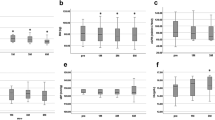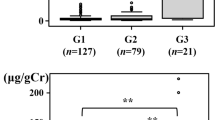Abstract
Background/aims
In diabetic patients, reduced urinary pH (UpH) is a predictive factor for cardiorenal-vascular disorders. Synthesis of glutathione, an anti-oxidative stress substance, is induced to counteract renal oxidative stress. UpH declines as glutamate is consumed, as does the synthesis of ammonia from glutamate. Glutathione is synthesized from glutamate and cysteine; however, in diabetes, the relationship between lowered UpH and the roles of renal amino acids is unknown. We, therefore, examined the relationship between amino-acid kinetics, UpH, and renal function.
Methods
This cross-sectional study targeted 100 non-diabetic obese individuals (OG: obese group) and 100 diabetics (DG: diabetic group). We investigated their blood amino acids, urinary amino-acid excretion, the reabsorption rates of various amino acids, and their relationship with the UpH and estimated glomerular filtration rate (eGFR).
Results
The DG subjects showed higher blood cysteine concentration, urinary glutamate, and cysteine excretions than the OG subjects. Although the glutamate reabsorption rate declined in the DG subjects, that of cysteine increased due to the lowered eGFR. The DG subjects’ urinary cysteine excretion correlated positively with UpH, making this urinary cysteine excretion the sole independent risk factor for lower UpH.
Conclusion
In patients with diabetes, the reabsorbed amount of cysteine, not glutamate, regulates the amount of glutathione synthesis in the kidneys. The more an amount of cysteine reabsorption increases concurrently with a decline in eGFR, the more its urinary excretion decreases. Under these conditions, concurrently, the glutamate consumption then increases, resulting in decreased ammonia synthesis and UpH.
Similar content being viewed by others
References
Wu Y, Zhang M, Liu R, Zhao C. Oxidative stress-activated NHE1 is involved in high glucose-induced apoptosis in renal tubular epithelial cells. Yonsei Med J. 2016;57:1252–9.
Souma T, Abe M, Moriguchi T, Takai J, Yanagisawa-Miyazawa N, Shibata E, Akiyama Y, Toyohara T, Suzuki T, Tanemoto M, Abe T, Sato H, Yamamoto M, Ito S. Luminal alkalinization attenuates proteinuria-induced oxidative damage in proximal tubular cells. J Am Soc Nephrol. 2011;22:635–48.
Sato E, Mori T, Satoh M, Fujiwara M, Nakamichi Y, Oba I, Ogawa S, Kinouchi Y, Sato H, Ito S, Hida W. Urinary angiotensinogen excretion is associated with blood pressure in obese young adults. Clin Exp Hypertens. 2016;38:203–8.
Ogawa S, Takiguchi J, Nako K, Okamura M, Sakamoto T, Kabayama S, Mori T, Kinouchi Y, Ito S. Elucidation of the etiology and characteristics of pink urine in young healthy subjects. Clin Exp Nephrol. 2015;19:822–9.
Ogawa S, Nako K, Okamura M, Ito S. Lower urinary pH is useful for predicting renovascular disorder onset in patients with diabetes. BMJ Open Diabetes Res Care. 2015;3:e000097.
Ogawa S, Mori T, Nako K, Kato T, Takeuchi K, Ito S. Angiotensin II type 1 receptor blockers reduce urinary oxidative stress markers in hypertensive diabetic nephropathy. Hypertension. 2006;47:699–705.
Ogawa S, Takiguchi J, Shimizu M, Nako K, Okamura M, Kinouchi Y, Ito S. The reduction in urinary glutamate excretion is responsible for lowering urinary pH in pink urine syndrome. Tohoku J Exp Med. 2016;239:103–10.
Tada K, Hirono H, Arakawa T. Endogenous renal clearance rates of free amino acids in prolinuric and Hartnup patients. Tohoku J Exp Med. 1967;93:57–61.
Hunter EA, Grimble RF. Dietary sulphur amino acid adequacy influences glutathione synthesis and glutathione-dependent enzymes during the inflammatory response to endotoxin and tumor necrosis factor-alpha in rats. Clin Sci (Lond). 1997;92:297–305.
Ferguson G, Bridge W. Glutamate cysteine ligase and the age-related decline in cellular glutathione: the therapeutic potential of γ-glutamylcysteine. Arch Biochem Biophys. 2016;593:12–23.
Chen Y, Dong H, Thompson DC, Shertzer HG, Nebert DW, Vasiliou V. Glutathione defense mechanism in liver injury: insights from animal models. Food Chem Toxicol. 2013;60:38–44.
Dalton TP, Chen Y, Schneider SN, Nebert DW, Shertzer HG. Genetically altered mice to evaluate glutathione homeostasis in health and disease. Free Radic Biol Med. 2004;37:1511–26.
Lu SC. Regulation of glutathione synthesis. Mol Aspects Med. 2009;30:42–59.
Lu SC. Glutathione synthesis. Biochim Biophys Acta. 2013;1830:3143–53.
Pathirana C, Grimble RF. Taurine and serine supplementation modulates the metabolic response to tumor necrosis factor alpha in rats fed a low protein diet. J Nutr. 1992;122:1369–75.
Nakatsu D, Horiuchi Y, Kano F, Noguchi Y, Sugawara T, Takamoto I, Kubota N, Kadowaki T, Murata M. l-cysteine reversibly inhibits glucose-induced biphasic insulin secretion and ATP production by inactivating PKM2. Proc Natl Acad Sci USA. 2015;112:E1067–76.
Dröge W. Oxidative stress and ageing: is ageing a cysteine deficiency syndrome? Philos Trans R Soc Lond B Biol Sci. 2005;360:2355–72.
Dröge W. Oxidative aging and insulin receptor signaling. J Gerontol A Biol Sci Med Sci. 2005;60:1378–85.
Dröge W, Kinscherf R. Aberrant insulin receptor signaling and amino acid homeostasis as a major cause of oxidative stress in aging. Antioxid Redox Signal. 2008;10:661–78.
Acknowledgements
The authors wish to thank Miss Asako Chiba and Mrs. Yasuko Sato for their assistance with gathering the urine samples for the study. We also wish to thank nurses Eiko Mitsui, Yoko Hasegawa, Michiko Ota, Megumi Ito, and Hiromi Sato for their efforts in gathering student data. Our deep appreciation goes to all members of the staff who helped us in this study.
Author information
Authors and Affiliations
Corresponding author
Ethics declarations
Funding statement
This work was supported by Tohoku University’s Center for the Advancement of Higher Education President’s Research Fund.
Conflict of interest
All the authors have declared no competing interest.
Research involving human participants and/or animals
Ethical approval: All procedures performed in studies involving human participants were in accordance with the ethical standards of the institutional and/or national research committee at which the studies were conducted (IRB approval number: 2015-1-139) and with the 1964 Helsinki declaration and its later amendments or comparable ethical standards.
Informed consent
Informed consent was obtained from all individual participants included in the study.
Author contributions
SO wrote the manuscript and researched the data, while MS, JT, KN, MO, and MK contributed to the collection of samples, the discussion, and researched the data. SI reviewed and edited the manuscript.
Electronic supplementary material
Below is the link to the electronic supplementary material.
About this article
Cite this article
Ogawa, S., Takiguchi, J., Shimizu, M. et al. The relationship between the renal reabsorption of cysteine and the lowered urinary pH in diabetics. Clin Exp Nephrol 21, 1044–1052 (2017). https://doi.org/10.1007/s10157-017-1401-1
Received:
Accepted:
Published:
Issue Date:
DOI: https://doi.org/10.1007/s10157-017-1401-1




